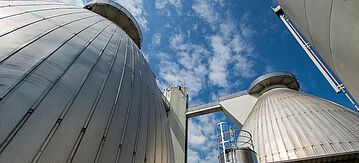Sewage sludge

Sewage sludge (water containing material separated from waste water via sedimentation) occurs in municipal sewage treatment plants where waste water, in particular from private households and similar facilities, is purified. Due to its relatively high nitrogen and phosphorous content, the sludge can be used as a fertiliser on agricultural land and in landscaping as long as pollution levels are very low.
Phosphorous and phosphorous compounds are essential for all living organisms. Without phosphorus, no organism can live or function. This applies in particular to the DNA of humans and animals, which carries genetic information and it is also essential for bones and teeth. Plants wither away if they cannot absorb sufficient phosphate Phosphorus is indispensable for the production of fertilisers. This is why it is such an essential raw material: it contributes to securing food worldwide.
In view of the significance of phosphorus as a raw material, the German Resource Efficiency Programme (ProgRess), which was adopted by the federal government in 2012, also stresses the need for a sustainable management of this material flow relevant for the protection of resources. The European Commission’s communication on an updated list of critical raw materials for the EU also rated phosphorus as a "critical raw material"; the same applies to the implementation of the raw material initiative of 26 May 2014. The 2014 list replaces the list drawn up in 2011, which at the time only identified 14 critical raw materials, not including phosphorus (phosphate rock).
In 2016, only about a third of the total of circa 1.8 million tonnes of municipal sewage sludge (dry weight) was used for fertilisation purposes in agriculture and landscaping. The remaining volume is for example used as secondary fuel in power plants and cement works or stored on landfills, which leads to the loss of valuable constituents of the sewage sludge, in particular phosphorus. Since 1 June 2005, landfilling of sewage sludge is only allowed after pre-treatment in an incineration plant or after mechanical-biological waste treatment. The soil-related use of sewage sludge in agriculture and landscaping takes place in accordance with the Sewage Sludge Ordinance, which, in addition to provisions laid down for fertilisers, specifies limit values for heavy metal and other pollutant loads in sewage sludge and in soils of plots selected for sewage sludge application.
These stipulations and strict provisions based on water and chemicals legislation have led to municipal sewage sludge pollutant loads having decreased in the case of some heavy metals by more than 90 percent over the last 40 years. Latest figures from 2016 confirm the continuation of this trend for the majority of heavy metals examined. This is also the case for several organic pollutants. Recently however, with some individual organic pollutants, pollution loads have not decreased any further.
The Sewage Sludge Ordinance of 1992 has been amended in order to return the valuable constituents of sewage sludge (phosphorus) to the economic cycle more intensively than has been done up to now with the soil-related application of sewage sludge and at the same time, to restrict conventional soil-related sewage sludge utilisation with a view to further reducing pollutant inputs into the soil. The Ordinance on the Reform of Sewage Sludge Utilisation of 27 September 2017 entered into force on 3 October 2017.
EU wide sewage sludge recovery is carried out in accordance with Council Directive 86/278/EEC of 12 June 1986 on the protection of the environment, and in particular of the soil, when sewage sludge is used in agriculture.
